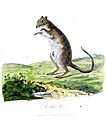Potoroo facts for kids
Quick facts for kids Potoroos |
|
|---|---|
 |
|
| Potorous platyops | |
| Scientific classification | |
| Kingdom: | |
| Phylum: | |
| Class: | |
| Infraclass: | |
| Order: | |
| Family: | |
| Subfamily: | |
| Genus: |
Potorous
Desmarest, 1804
|
| Type species | |
| Didelphis murina |
|
| Species | |
A potoroo is a small marsupial that looks a bit like a rat or a tiny kangaroo. These amazing animals are found only in Australia. They are part of a group of animals called Potoroidae, which also includes bettongs.
Potoroo means "kangaroo rat" in an Indigenous Australian language. They are mostly active at night. Potoroos use their strong hind legs to hop around. They also have a long tail that helps them balance.
Contents
What are Potoroos?
Potoroo is the name for any animal in the genus Potorous. They are small, shy creatures. Potoroos are mammals, which means they are warm-blooded and have fur. Like other marsupials, female potoroos carry their babies in a pouch.
There are four main types, or species, of potoroos:
- Gilbert's Potoroo (Potorous gilbertii)
- Long-footed Potoroo (Potorous longipes)
- Long-nosed Potoroo (Potorous tridactylus)
- The Broad-faced Potoroo (Potorous platyops) is sadly extinct.
Where Potoroos Live
Potoroo species live in different parts of Australia. They prefer areas with dense vegetation. This thick plant cover helps them hide from predators. You can find them in forests, woodlands, and even some coastal areas.
What Potoroos Eat
Potoroo are mostly herbivores, meaning they eat plants. Their diet mainly consists of underground fungi, like truffles. They use their strong claws and long noses to dig for these tasty treats. They also eat seeds, fruits, and insects. This diet helps spread plant seeds and fungal spores.
Potoroo Life and Habits
Potoroo are generally nocturnal animals. This means they are most active during the night. They spend their days resting in hidden nests. These nests are often made from grass and leaves. They are usually built in shallow hollows in the ground.
Reproduction
Female potoroos usually have one baby at a time. The tiny, undeveloped baby crawls into its mother's pouch. It stays there, drinking milk and growing, for several months. Once it leaves the pouch, the young potoroo continues to stay close to its mother. It learns how to find food and survive on its own.
Threats to Potoroos
Many potoroo species are endangered. This means they are at risk of disappearing forever. The main threats to potoroos include habitat loss and habitat fragmentation. This happens when their homes are destroyed or broken up by human activities. Predation by introduced animals, like foxes and cats, is also a big problem. Conservation efforts are working to protect these unique Australian animals.
Images for kids
-
Illustration by Sarah Stone for John White, 1790
See also
 In Spanish: Potorúes para niños
In Spanish: Potorúes para niños


